Dreams have no limits, and nothing is impossible. If you’ve ever doubted your ability to achieve your aspirations, then Nirmal “Nimsdai” Purja’s remarkable feat of climbing the world’s 14 highest mountains in just six months will surely motivate you! Hailing from the Nepali Himalayas, Nimsdai shattered the previous record of seven years to complete the challenge of ascending all 14 peaks over 8,000m (26,247 ft.).
Visualize the unwavering determination, resilience, and sheer willpower that Nimsdai displayed in his quest to conquer the highest mountains in the world. Whether you’re striving to fulfill a lifelong dream or a similar peak-climbing goal, your 14 peaks await. Are you ready to take on the challenge?
If you’re planning to tackle your personal 14 peaks, it’s wise to familiarize yourself with the top climbing peaks in Nepal.
| S.N. | Mountain | Height | First Summiteer | Summit Date |
|---|---|---|---|---|
| 1 | Everest | 8,848m/29,030 ft. | T. Norgay Sherpa, E. Hillary. | May 29, 1953 |
| 2 | K2 | 8,611m/28,250 ft. | A. Compagnoni, L. Lacedelli. | July 31, 1954 |
| 3 | Kanchenjunga | 8,586m/28,169 ft. | G. Band, J. Brown, N. Hardie, S. Streather. | May 25, 1955 |
| 4 | Lhotse | 8,516m/27,940 ft. | F. Luchsinger, E. Reiss. | May 18, 1956 |
| 5 | Makalu | 8,463m/27,766 ft. | J. Couzy, L. Terray, J. Franco, G. Magnone-Gialtsen, J. Bouier, S. Coup, P. Leroux, A. Vialatte. | May 15, 1955 |
| 6 | Cho-Oyu | 8,201m/26,906 ft. | H. Tichy, S. Jchler, Pasang Dawa Lama. | Oct. 19, 1954 |
| 7 | Dhaulagiri | 8,167m/26,795 ft. | A. Schelbert, E. Forrer, K. Diemberger, P. Diener, Nyima Dorji, Nawang Dorji. | May 13, 1960 |
| 8 | Manaslu | 8,163m/26,781 ft. | T. Imamishi, K. Kato, M. Higeta,G. Norbu. | May 9, 1956 |
| 9 | Nanga Parbat | 8,125m/26,660 ft. | Hermann Buhl. | July 3, 1953 |
| 10 | Annapurna | 8,091m/26,545 ft. | M. Herzog, L. Lachenal. | June 3, 1950 |
| 11 | Gasherbrum I | 8,068m/26,470 ft. | P. K. Schoeing, A. J. Kauffman. | July 4, 1958 |
| 12 | Broad Peak | 8,047m/26,400 ft. | M. Schmuck, F. Wintersteller, K. Diemberger, H. Buhl. | June 9, 1957 |
| 13 | Gasherbrum II | 8,035m/26,360 ft. | F. Moravec, S. Larch, H. Willenpar. | July 7, 1956 |
| 14 | Shishapangma | 8,013m/26,289 ft | Xǔ Jìng, Zhāng Jùnyán, Wang Fuzhou, Wū Zōngyuè, Chén Sān, Soinam Dorjê, Chéng Tiānliàng, Migmar Zhaxi, Dorjê, and Yún Dēng. | May 2, 1964 |
Step out of your comfort zone and challenge yourself physically and mentally with these 14 peaks. Here’s what you can expect from the magnificent 8,000-ers of the world.
1. Mt. Everest (8,848m/29,030 ft)
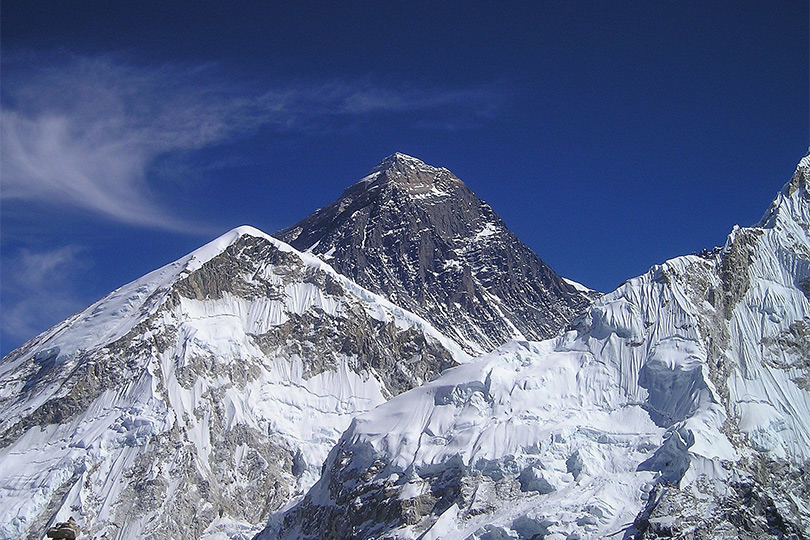
Everest, the highest peak in the world, is the ultimate dream for many climbers. Achieving this personal milestone requires immense perseverance, determination, and a good deal of planning. Knowing the mountain is also a crucial aspect of peak climbing. Here are some interesting facts about Mt. Everest:
- Named after George Everest, Mt. Everest is actually called “Sagarmatha” in Nepali and “Chomolungma” in Tibetan.
- Once covered by the ocean, the tallest mountain in the world based on undersea measurements is Hawaiis’ Mauna Kea, which is 10,211 meters (33,500 ft.) from base to summit.
- The south face of Everest, accessible from Nepal, is the easier ascent route. It opened for climbers after the Chinese Cultural Revolution in 1966 made the Tibetan side inaccessible to foreign climbers.
If you’re planning to climb Everest, there are many more fascinating facts about Mt. Everest that will interest and inspire you!
2. K2 (8,610 m/ 28,250 ft)
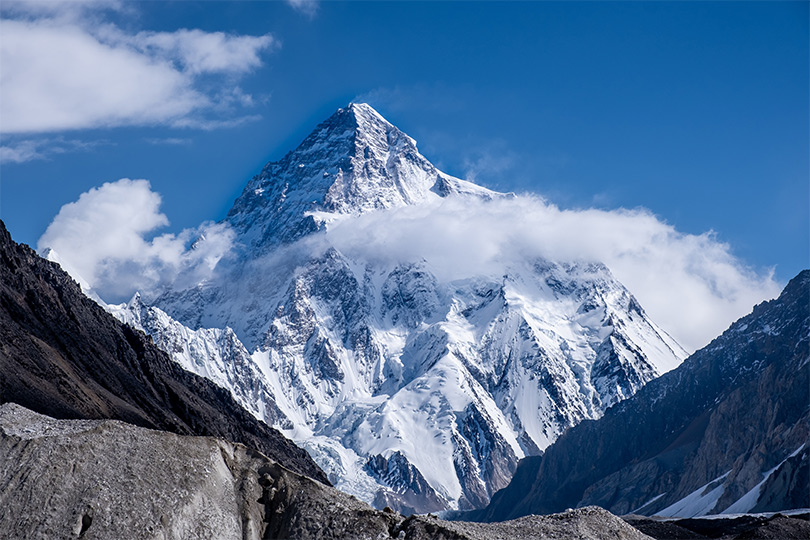
Although it may not be the tallest, K2 is widely considered the most perilous mountain to climb. The icy pyramid has claimed the lives of one in every four climbers who have attempted to summit it, earning it a reputation that strikes fear into the hearts of even the bravest mountaineers. Like the Everest base camp trek, reaching the K2 basecamp is an arduous challenge that provides a gateway to an entirely different world. Here are a few intriguing facts about this mountain:
- Known as the “Savage Mountain” after George Bell used the term to describe it following his failed ascent in 1953. His exact words were “it’s a savage mountain that tries to kill you”.
- Until recently, K2 was the only mountain without a winter ascent. However, during Nimsdai’s journey to climb the 14 peaks, his team of 10 successfully completed a winter ascent of K2.
- K2 is one of the seven 2nd summits, which contributes to the theory that it is tougher to climb the second-highest peak of each continent than the highest.
3. Kanchenjunga (8,586m/28,169 ft)
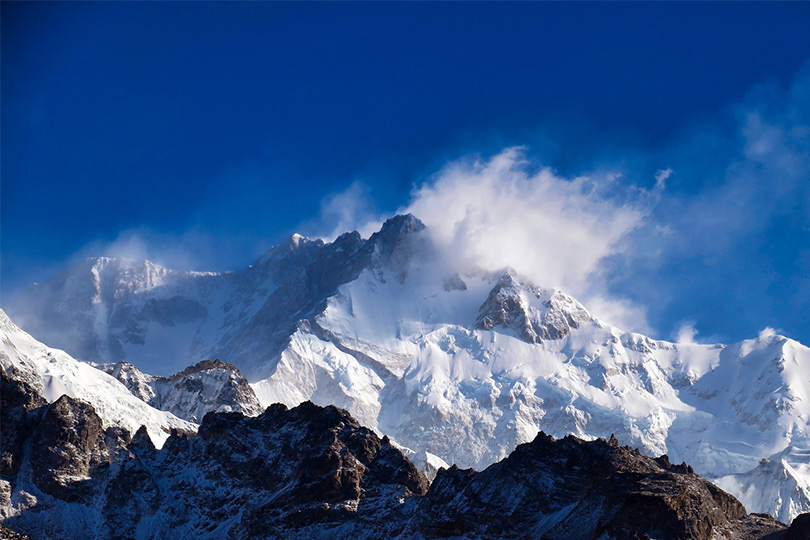
Unlike its other 8000-er brethren, Kanchenjunga shares its immensity with 3 countries – Nepal, India, and Tibet. Furthermore, despite it having multiple access points, none of them are considered “easier” or “safer” due to the high avalanche risk levels. Due to the immense risks, you should be as well informed about the mountain as possible. Here are some facts about Kanchenjunga:
- Until the discovery of Mt. Everest in 1852, Kanchenjunga was actually thought to be the tallest mountain in the world.
- It has five peaks, which is how it gets its name “Kanchenjunga” which translates to “Five Treasures of Snow” in Tibetan. There are also legends claiming the existence of a valley of immortality hidden on its slopes
- The summit is considered sacred in multiple cultures. The area around the mountain is said to be home to a Yeti. It was believed to have been spotted by a British expedition in 1925.
4. Lhotse (8,516m/27,940 ft.)
Only 3km south of Everest, Lhotse is actually connected to Mt. Everest by the South Col, a massive ridge. This connection is also how it got its’ name. Lhotse means “South Peak” in Tibetan. Climbed from the west face, the Lhotse expedition even shares the initial climbing routes with Everest. Here are some facts about Lhotse:
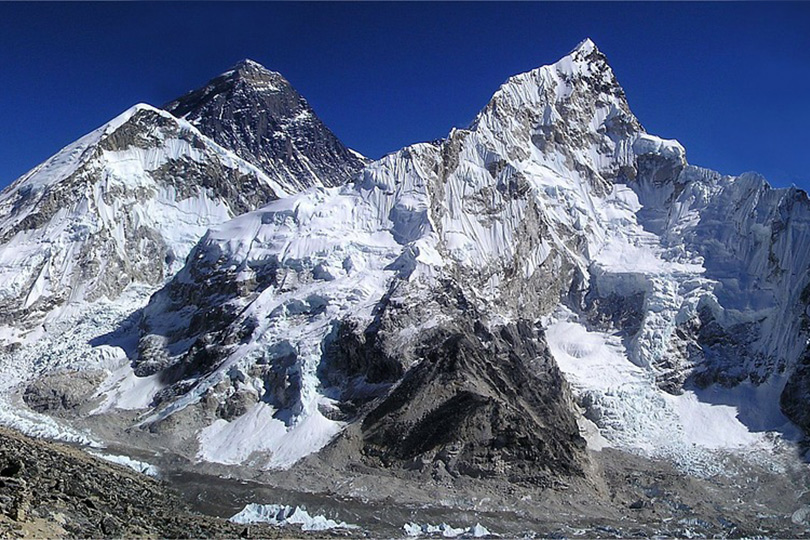
- Lhotse has three summits: Lhotse Main, Lhotse Shar, and Lhotse Middle. Despite this, it was confused to be Everest’s southern peak.
- Not unlike Columbus’s faulty mission to India during which he discovered America, Lhotse was climbed in 1956 AD as an easier route to the Everest summit.
- To summit the mountain, one must ascend from the western flank, or the Lhotse face, which is an imposing blue glacial wall rising at a 40o-50o punctuated with the occasional 80o slope.
5. Makalu (8,463m/27,766 ft.)
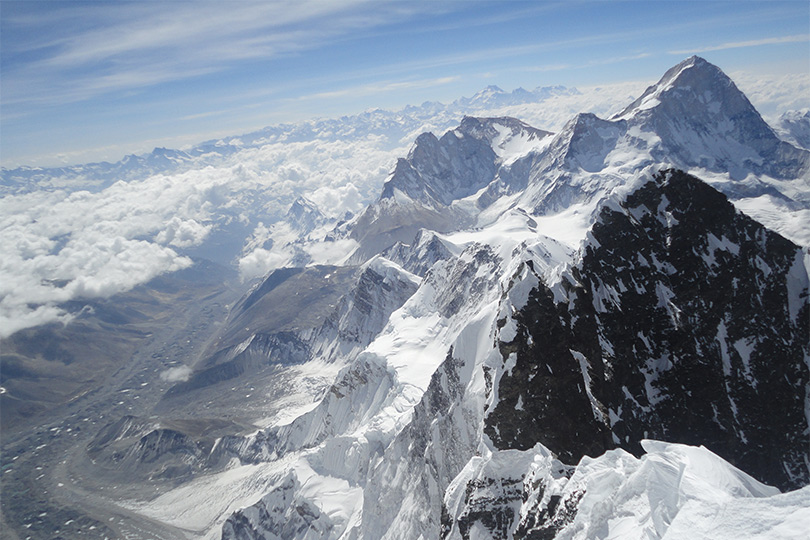
The fifth highest mountain in the world, Makalu lies on the Mahalangur Himalayan range. Deadly to climbers, Makalus’ razor-sharp edges make up a 4-faced pyramid. It is a dramatic, isolated peak lying on the Nepali and Tibetan border. Despite this, attempted from the Nepali side, Makalu is relatively safer compared to its deadlier brethren such as K2, Annapurna, and Lhotse. Here are some interesting about Makalu:
- The name Makalu is derived from the Sanskrit Maha Kala, a name for the Hindu god Shiva, symbolizing the destructive form of Shiva. Its tentative translation would be “The great doom”, often misconstrued as “the big black”.
- Makula lies within Nepal’s Makalu-Barun National Park and Conservation Area, a 580-sq.mile parkland that protects pristine ecosystems from tropical rainforests to alpine tundra.
- Not to be confused with Chomolungma, Everests’ Tibetan name, one of Makalus’ 2 subsidiary summits is Chomolonzo (7,678m/25,650 ft.) is two miles northwest of the main Makalu summit.
6. Cho-Oyu (8,201m/26,906 ft.)
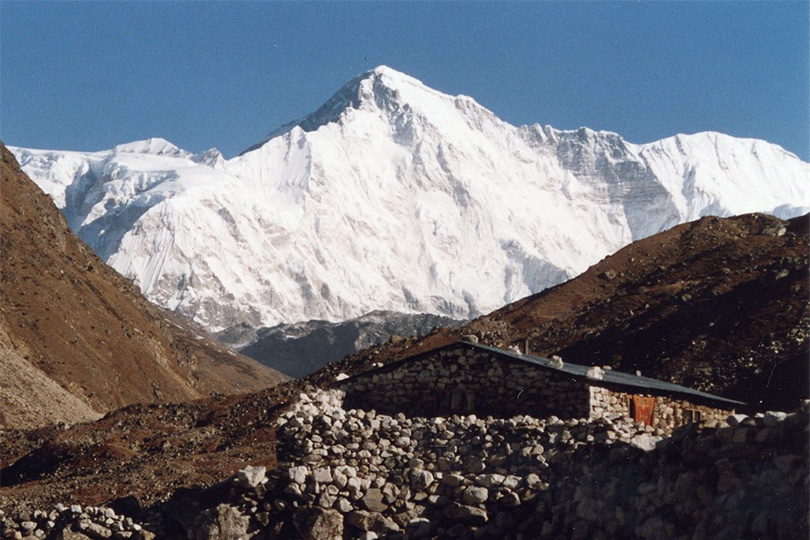
The second most climbed 8000er (the first being Everest), Cho-Oyu is considered one of the easier mountains to climb. When climbed from its Northeast face there are limited technical portions, which attracts many climbers. The Cho-Oyu basecamp is actually accessible by Jeep, and can even be made in a two-day trip from Kathmandu. Seems incredible that this should be possible, but here are some more facts about the mountain.
- Cho-Oyu is a beautiful mountain, evidenced by its Tibetan name, which means the “Turquoise Goddess” due to its dazzling colors in the sunset.
- A comparatively simpler climb, it can be completed in a window of 6 to 10 weeks. The entire route is separated into short, scenic but intense climbs.
- Unlike its neighboring 8000-ers such as Everest and Makalu, Cho-Oyu is a wider plateau structure.
7. Dhaulagiri (8,167m/26,795 ft.)
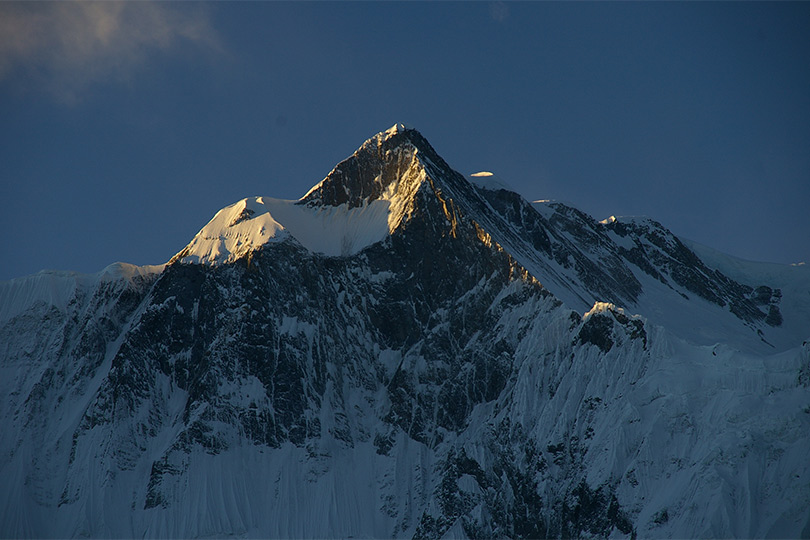
The highest peak lying solely in Nepal, Dhaulagiri is the 7th highest mountain in the world. It was considered the highest mountain in the world for 30 years until the discovery of Kanchenjunga in 1838. Lying on the Dhaulagiri Himalayan range, it’s separated from Mt. Annapurna by the Kali Gandaki River. Get to know the Nepali mountain:
- Dhaulagiri stands over the great Kali Gandaki Valley, which by some measures is the deepest gorge on earth, as it is flanked by two of the 14 highest peaks in the world.
- It dethroned Mt. Chimborazo (6,263.47 m/20,549.4 ft.) in Ecuador as the tallest peak in 1808.
- The most agreeable face to scale Dhaulagiri is its’ Northeastern flank.
8. Manaslu (8,163m/26,781 ft.)
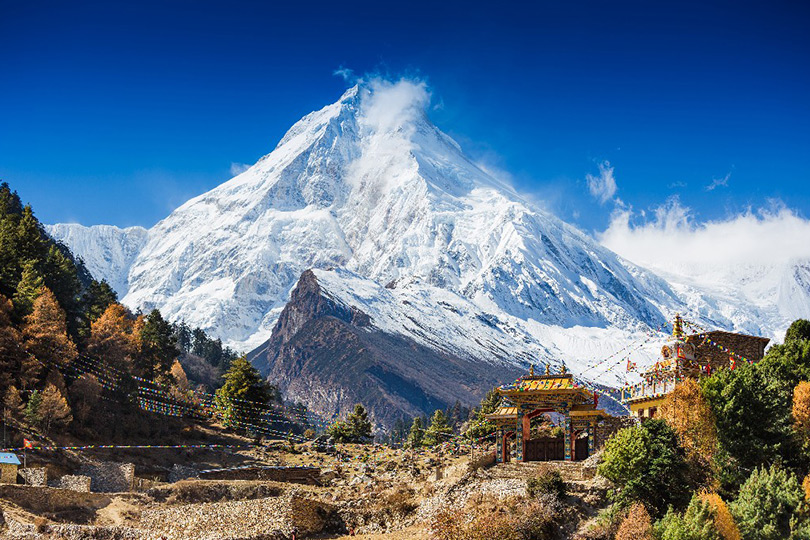
Lying in the pristine, protected Manaslu region, Mt. Manaslu is a part of the northern Himalayan range in Gorkha in Nepal. It shares trekking circuits with its western Nepal counterpart Annapurna. Get to know the relatively unexplored mountain:
- One a part of the silk route through the Eurasian mountains, the Manaslu trail follows the trail ancient salt-trading route along the Budhi Gandaki river.
- Its’ name is as serene as its location. Manaslu is “the mountain of the spirit”, based on the Sanskrit word “Manasa”, roughly translating to mean soul.
- The neat mountain’s long ridges and valley glaciers make it a relatively straightforward climb from all its faces.
9. Nanga Parbat (8,125m/26,660 ft.)
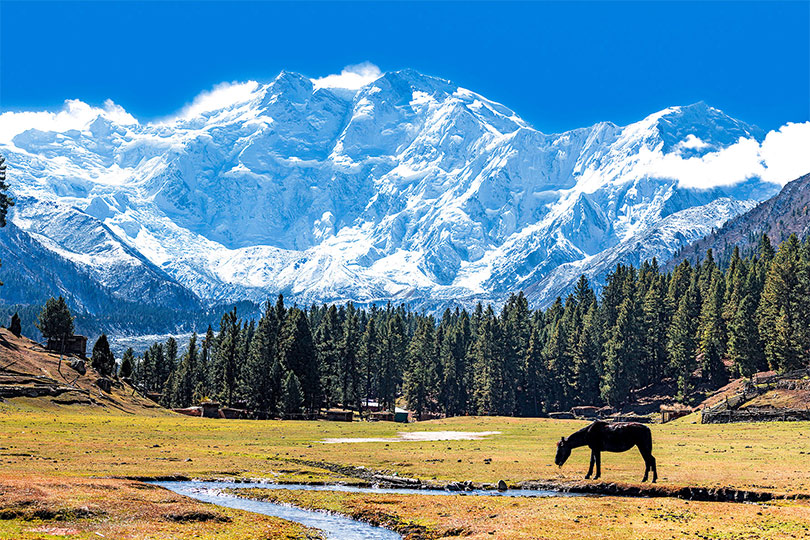
Lying immediately southeast of the northernmost bend of the Indus River in the Gilgit-Baltistan region of Pakistan-administered Kashmir, Nanga Parbat is the westernmost major peak of the Himalayas. A dramatic peak rising from the beautiful Kashmiri valley, Nanga Parbat is considered to be the anchor of the Himalayas. Some interesting facts about it:
- Nanga Parbat is one of the dangerous 8000ers. It is even called the “Killer Mountain” due to the higher level of risks.
- The name Nanga Parbat is derived from the Sanskrit words “nanga” and “parvata”, which translate to “Naked Mountain” when combined. It’s locally by its Tibetan name Diamer or Deo Mir, meaning “huge mountain”.
- It is notably vertical from all vantage points.
10. Annapurna (8,091m/26,545 ft.)
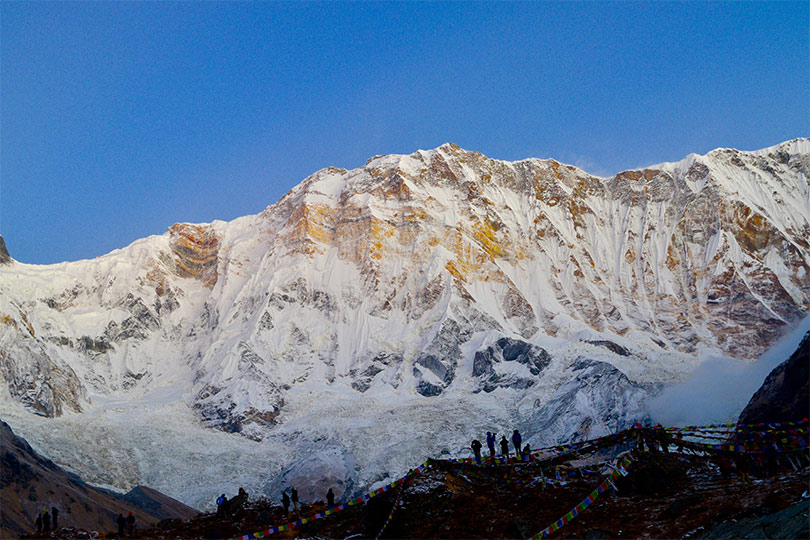
Considered to be the most dangerous of the 14 highest peaks in the world, Annapurna is a testament that the difficulty level of your goal is not relative to its size. Climbing Annapurna would be a true challenge. Here are some fascinating facts about Annapurna:
- Annapurna is named after the goddess of plenty, or bountiful yield believed to reside in the mountain’s treacherous slopes. The word “Annapurna” is the Sanskrit word equivalent of a cornucopia.
- Technically, the mountain we refer to is called Annapurna I owing to it actually being a part of a massif with multiple peaks consisting of thirteen peaks over 7,000m and sixteen others over 6,000m.
- The deadly mountain has a mortality rate of 38%.
11. Gasherbrum I (8,068m/26,470 ft.)
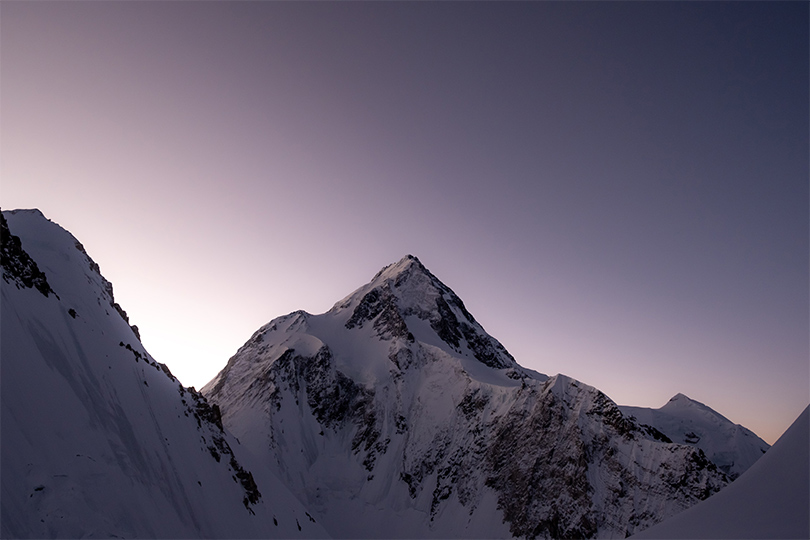
A part of the Gasherbrum massif, the Gasherbrum I is alternatively known as the “Hidden Mountain” due to its extreme remoteness. Also lying in the Kashmiri region, Gasherbrum is a part of the Karakoram Range. Of the world’s fourteen highest mountains, four are located within this range: K2, Gasherbrum I and II, and Broad Peak. Get to know the mountain better:
- Discovered in the same survey as K2, Gasherbrum was called K5. It’s name is derived from Balti words “rgasha” and “brum” which translate to mean Beautiful Mountain.
- It is the least climbed of the 8000-ers with less than 200 ascents.
- The peak is traditionally attempted from the western side. However, all routes here lead to “The Japanese Couloir”, located on top of the northwest face from where climbers continue on to the peak.
12. Broad Peak (8,047m/26,400 ft.)
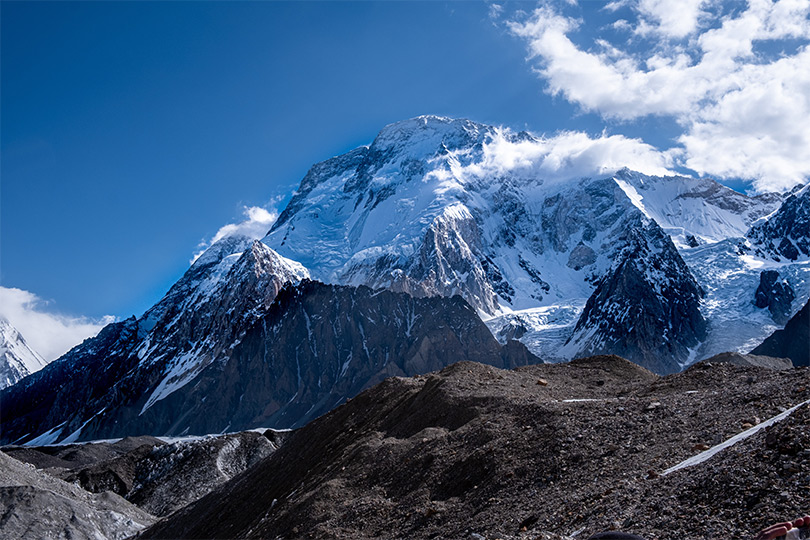
Located about 8km (5 miles) from K2, Broad Peak is part of the Gasherbrum massif in Baltistan on the border of Pakistan and China. It is located in the climatically harsher and colder of the mountain ranges: the Karakoram mountain range. Interestingly, Broad Peak has a summit of over 1.5 km (almost 1 mile) long and thus the name.
- Broad Peak is one of the objectively safest eight-thousanders which also has a very high success rate. Like Cho-Oyu, the route is direct, relatively short and the few difficult passages are secured with fixed ropes.
- The mountain has five summits: Broad Peak, Rocky Summit, Broad Peak Central, Broad Peak North, and Kharut Kangri.
- It has also been called the Breithorn (the massive three-headed peak of the European Alps) of the Baltoro.
13. Gasherbrum II (8,035m/26,360 ft.)

The 13th of the 14 peaks, Gasherbrum II is another one of Karakorams’ 8000-er peaks. With none of the steep slopes that other 8000-er peaks have and comparatively less technical and mixed climbing, Gasherbrum II is considered a relatively easy climb. Despite the unfavorable weather conditions, if you’re daunted by some of the tougher peaks, Gasherbrum II is a safer challenge. Here are some interesting facts about the mountain:
- The giant mountain is perched on top of Pakistan’s Baltoro Glacier, part of the 6 Gasherbrum peaks.
- In the same survey by British surveyor Montgomery which spotted K2 and Broad Peak, Gasherbrum II was temporarily named K4.
- In August 1986, Gasherbrum II was successfully ascended by a Slovene expedition in only 32 hours from the base to the peak, with only 22 hours of climbing and 10 hours of rest at the altitude of 5900 m. This was by far the fastest ascent until then.
14. Shishapangma (8,013m/26,289 ft.)

Just 5km shy of Nepal on the Tibetan border, Shishapangma is the last of the 14 highest peaks in the world. Due to its location in the Chinese province, it is perhaps the least accessible 8000-er. In fact, the mountain was closed down to climbers by the Chinese government, citing safety reasons. At the request of the Nepali government, Nimsdai and his team were issued a climbing permit for Shishapangma by China for his mission. Here are some little known facts about the peak:
- Sishapangma in Tibetan is roughly translated to “God of the Grasslands”. However, the Sanskrit name of the mountain, Gosainthan, (meaning “Abode of God”) has been found to be used in pop culture.
- The only 8000-er completely in Chinese territory, Shishapangma lies on the dry north side of the Himalayan crest. It has less dramatic vertical relief than most major Himalayan peaks.
- Most successful ascends (including the first) had been attempted from the Northern side.
Ready to challenge yourself with these 14 peaks and make memories of a lifetime? If you have any questions about the 14 highest peaks in the world or peak climbing in Nepal, don’t hesitate to contact us. We’re here to help you step out of your comfort zone and take your climbing to the next level. If you’re feeling unsure about the expeditions, our travel experts are just a WhatsApp message away at +1-860-593-156. Good luck on your journey!






